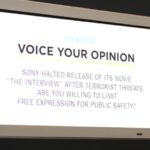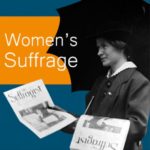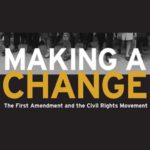Students will inductively discover the First Amendment by reading and analyzing newspapers. They will discuss various circumstances involving the First Amendment, and so understand that in certain instances – libel, publication of national secrets, etc. – there is a limit to the freedoms expressed in the First Amendment.
Free Speech Essentials
Do your students know what they’re free to say online? At school? On a public street corner? From censorship to cyberbullying, the First Amendment and the freedoms it protects are as hotly contested as ever. This EDCollection explores 16 free speech debates ranging from the founding of our nation to recent headlines to illustrate what free speech actually means, where it comes from, and how far it can go. Whether you’re a social studies teacher looking for a complete unit or an English teacher looking to spend a single class period on free expression, there’s something for everyone. Free registration required.
You Can’t Say That: In My Opinion

Apply what you learned about constitutional exceptions to the First Amendment by studying a modern situations. Be sure to summarize the facts of the situation and then present your opinion about whether the actions of the individual in the scenario were protected by the First Amendment. If you disagree with the court, school or law enforcement’s decision, be sure to explain why you disagree.
Women, Their Rights and Nothing Less: The First Amendment and the Women’s Suffrage Movement

Use this map to explore how the women’s suffrage movement — and the people who opposed it — tried to influence public opinion. Explore artifacts from billboards and cards to buttons and cartoons. You’ll uncover the wide array of tools and tactics each side used to spread its message, and you’ll see how geography and other factors shaped the form and content of their communication.
First Amendment: Speech
When does the First Amendment allow the government to limit speech? Many Americans struggle with understanding the language and subsequent interpretation of the Constitution, especially when it comes to the rights encapsulated in the First Amendment. While many Americans can agree that speech should be protected, there are disagreements over when, where, and how speech should be limited or restricted. This lesson encourages students to examine their own assumptions and to deepen their understanding of current accepted interpretation of speech rights under the First Amendment, including when and where speech is protected and/or limited. It should reinforce the robustness of the First Amendment protections of speech.
The Press and the Civil Rights Movement Video Lesson

Civil rights leaders effectively used the First Amendment and the press to expose the injustices of racial segregation. Reporters who covered the civil rights struggle give up close and personal accounts. Learn more about the First Amendment’s power to bring about profound social change and the role and challenges a free press embraces when tackling controversial issues.
Making a Change: The First Amendment and the Civil Rights Movement

Delve into hundreds of historical newspapers, videos, photographs and more to find out how the five freedoms empowered people fighting for change — and those fighting against it. Topics include: the history of the American civil rights movement, the relationship between the movement and the news media, the evolution and application of First Amendment freedoms, bias in the news, civic engagement and more.
Government Speech Under the First Amendment
This lesson teaches students, through a simulation related to government-sponsored Confederate monuments, about the government-speech doctrine under the First Amendment. In particular, this lesson aims to (1) introduce students to the issue of government speech; (2) teach the doctrine; (3) apply the doctrine in a contemporary context; and (4) critically analyze the doctrine.
The Pursuit of Justice
The Pursuit of Justice book, written by Kermit L. Hall and John J. Patrick, analyzes 30 Supreme Court cases chosen by a group of Supreme Court justices and leading civics educators as the most important for American citizens to understand. An additional 100 significant cases included in state history and civics standards are summarized. The complete book or individuals chapters can be downloaded.
IRL 1: Free Speech in Schools Podcast
We’re digging into four incredibly important Supreme Court cases – four cases that have shaped how we interpret the meaning of free speech in public schools. Is political protest allowed in class? Is lewd speech covered by the First Amendment? Can school administrators determine what students can and can’t say in the school newspaper? Listen in, and find out how students and schools have gone head to head over how First Amendment rights apply in a public school setting.